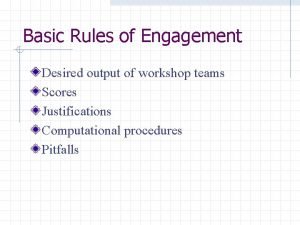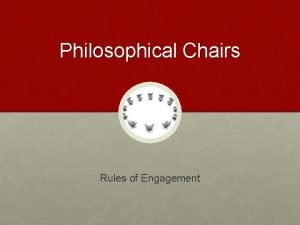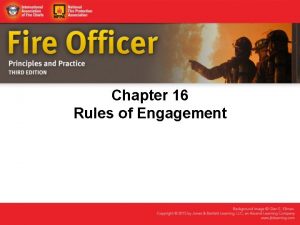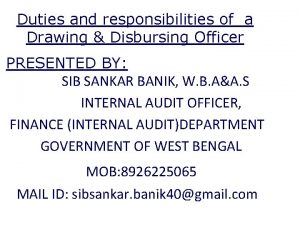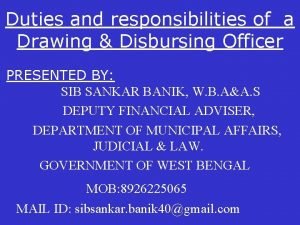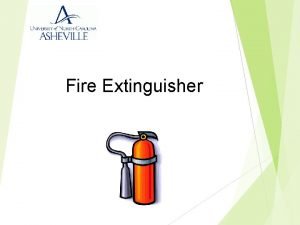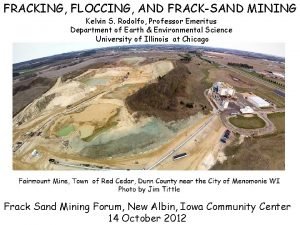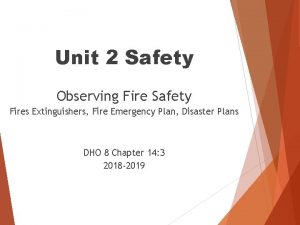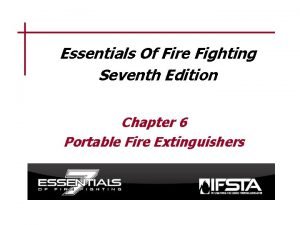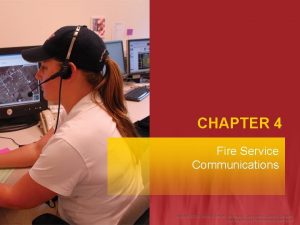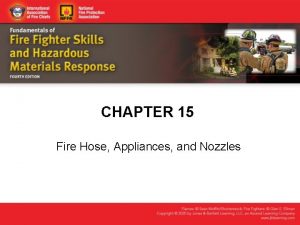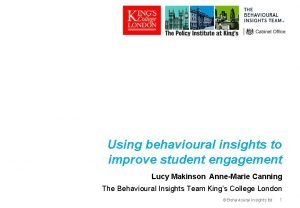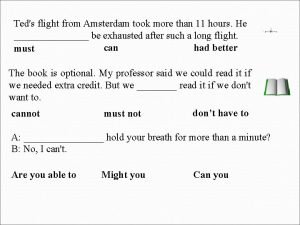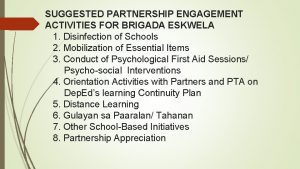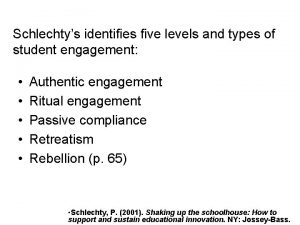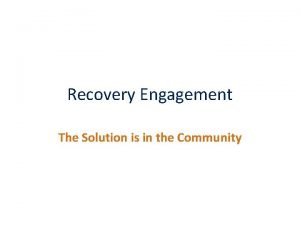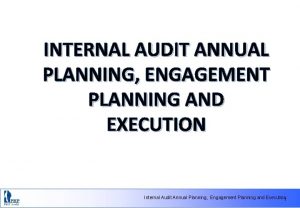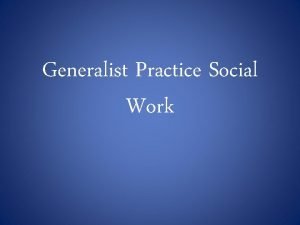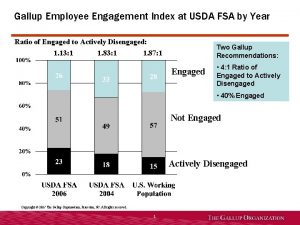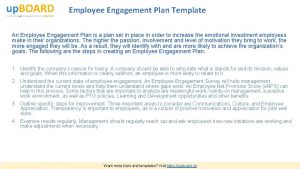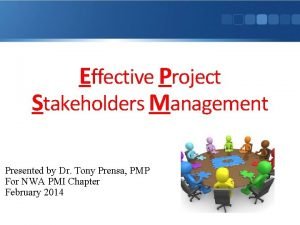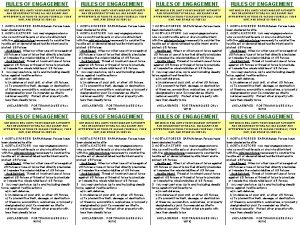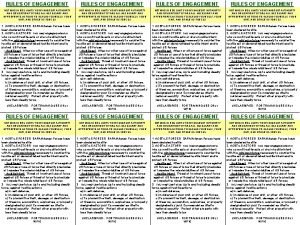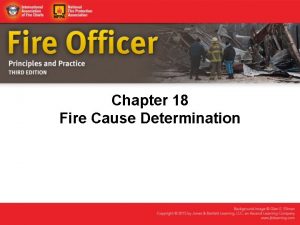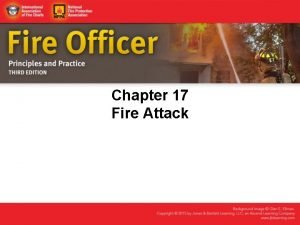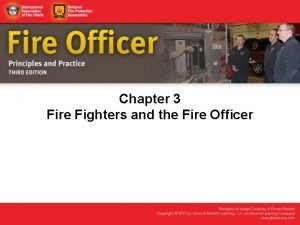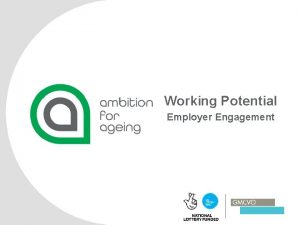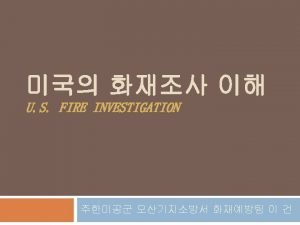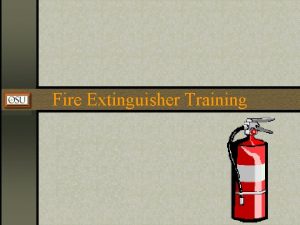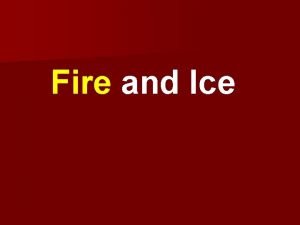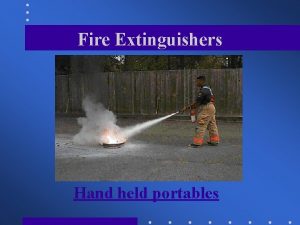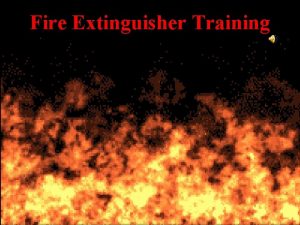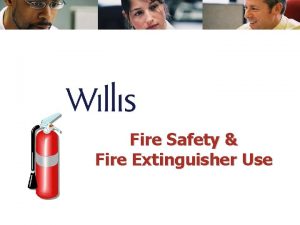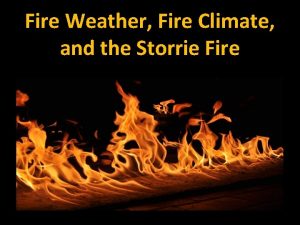Chapter 16 Rules of Engagement Fire Officer I






















































- Slides: 54

Chapter 16 Rules of Engagement

Fire Officer I Objectives • Discuss the origins of the Rules of Engagement (ROE). • Describe the scope of the line-of-duty death problem. • Describe the elements of size-up. • Discuss occupant survivability in terms of fire behavior and fire fighter safety.

Fire Officer I Objectives • Discuss the concept that lives should not be risked for lives or property that cannot be saved. • Discuss the level of risk extended to protect savable property. • Discuss the level of risk extended to protect savable lives.

Fire Officer I Objectives • Discuss the importance of fire fighters staying together. • Discuss the importance of maintaining situational awareness. • Discuss the importance of fire-ground communications.

Fire Officer I Objectives • Discuss the importance of reporting unsafe practices or conditions. • Discuss the value of retreat in unsafe conditions. • Describe when a mayday should be declared.

Fire Officer II Objectives • Describe the scope of the line-of-duty death problem. • Describe the elements of size-up. • Discuss occupant survivability in terms of fire behavior and fire fighter safety. • Discuss the origins of the Rules of Engagement (ROE).

Fire Officer II Objectives • Discuss the concept that lives should not be risked for lives or property that cannot be saved. • Discuss the level of risk extended to protect savable property. • Discuss the level of risk extended to protect savable lives.

Fire Officer II Objectives • Discuss the importance of fire fighters staying together. • Discuss the importance of maintaining situational awareness. • Discuss the importance of fire-ground communications.

Fire Officer II Objectives • Discuss the importance of reporting unsafe practices or conditions. • Discuss the value of retreat in unsafe conditions. • Describe when a mayday should be declared.

Introduction

How the Rules Came to Be • The Rules of Engagement (ROE) evolved from “Rules” developed by the Seattle IAFC Safety Committee. – Focus on the fire fighter and fire officer working at the task level of fire suppression operations

How the Rules Came to Be • Rules of Engagement criteria: – Be a short, specific set of bullet points – Be easily taught and remembered – Define critical risk issues – Define “go” and “no go” situations

Understanding the Scope of the Problem • Open versus enclosed structures – More than three-fourths of fire fighter deaths occur in enclosed structures.

• Captain Stephen Marsar explored the concept of survivability profiling. Reproduced from Marsar, S. (2011, November) “Survivability Profiling Takes Size-Up to a New Level: Firefighters must consider not just whether victims might be inside, but whether they can still be alive. ” Fire Rescue Magazine. Survivability Profiling

Fire Fighter Survivability Inside Structure Fires • Trend: increases number of traumatic injuries while operating inside structures – The fire department and the company officer must minimize exposure to unsafe conditions. – The ROE integrate the fire fighter into the risk assessment decision-making process.

Rule 1. Size up Your Tactical Area of Operation • Objective: To cause the company officer and fire fighters to look over their area of operation, evaluate their risk exposure, and determine a safe approach to complete objectives.

Rule 1. Size up Your Tactical Area of Operation • Lack of a complete size-up is often a contributing factor in fire fighter deaths. – The fire attack crew should size up the total situation within their line of sight. – The first-arriving company officer or team leader must cover each side of the fire ground.

Rule 2. Determine the Occupant Survival Profile • Objective: To cause the company officer and fire fighter to consider five conditions in relation to possible occupant survival of a rescue event.

Rule 2. Determine the Occupant Survival Profile • The essential component in size-up is to determine whether any occupants are trapped and whether they can survive. – If survival is not possible, a more cautious approach to fire operations must be taken.

Today’s Smoke Is More Toxic – Growing fire conditions – Resources on scene – Time needed to complete a rescue © Glen E. Ellman • When making the decision to conduct search and rescue operations, factor in:

Rule 3. Don’t Risk Your Life for Lives or Property That Can’t Be Saved • Objective: To prevent fire fighters from engaging in high-risk operations when fire conditions prevent occupant survival and significant or total destruction of the building is inevitable.

Rule 3. Don’t Risk Your Life for Lives or Property That Can’t Be Saved • If conditions indicate no occupant can survive the fire conditions, operations should be suspended until the fire has been controlled.

Lives That Could Not Be Saved • A quint and an engine responded to a structure fire with children trapped. – The search team brought out two of the trapped children in cardiac arrest. • Should have been indication that it was unlikely any additional occupants could survive

Rule 4. Extend Limited Risk to Protect Savable Property • Objective: To cause fire fighters to limit their risk exposure to a reasonable, cautious, and conservative level when trying to save a building.

• No building is worth the life of a fire fighter. • Interior operations must be fully supported with adequate resources. Reproduced from: Figure 1 from: Safety, Health, and Survival Section. (2012). Rules of Engagement for Structural Firefighting: Rule 4. Extend Limited Risk to Protect Savable Property

Rule 5. Extend Vigilance to Protect and Rescue Savable Lives • Objective: To cause fire fighters to manage operations in a calculated, controlled, and safe manner, while remaining alert to changing conditions.

• During search and rescue operations, crews must remain vigilant and measured. • Members should continually assess fire conditions. © Glen E. Ellman Rule 5. Extend Vigilance to Protect and Rescue Savable Lives

Deteriorating Conditions • The situation can deteriorate rapidly. • Fire fighters must remain aware of changing conditions.

Rule 6. Go in Together, Stay Together, Come out Together • Objective: To ensure that fire fighters always enter a burning building as a team of two or more members and that no fire fighter is allowed to be alone at any time while entering, operating in, or exiting a building.

Rule 6. Go in Together, Stay Together, Come out Together • Situations when a fire fighter is alone in a burning structure: – Fire fighter becomes separated from crew – Single fire fighter freelancing – Fire fighter entering a structure alone – Fire fighter leaving when low on SCBA air

Rule 6. Go in Together, Stay Together, Come out Together • Crew integrity is critical for survival. – Stay together in teams of two or more. – Freelancing is strictly prohibited. • If a fire fighter becomes separated, he or she must immediately communicate with the company officer or the fire fighter’s partner.

Rule 7. Maintain Continuous Awareness • Objective: To cause all fire fighters and company officers to maintain constant situational awareness of their SCBA air supply and where they are in the building, as well as all that is happening that may affect their risk and safety.

Rule 7. Maintain Continuous Awareness – Running out of air – Getting caught in rapidly deteriorating conditions – Becoming disoriented and lost © Glen E. Ellman • Major factors in fire fighter deaths:

Rule 7. Maintain Continuous Awareness • NFPA 1404 requires an air management program. • NFPA 1500 requires standardized IDLH exiting to be practiced. • NFPA 1852 requires fire fighters to confirm the SCBA is fully functional.

Rule 7. Maintain Continuous Awareness • Benchmarks for checking air supply: – Before entry – After going up or down stairs – Before entering and searching a room – After exiting a room – After going down a hallway or aisle – Before and after doing a demanding task

Air Management as a Situational Awareness Tool • Situational awareness: level of understanding one has regarding the reality of a set of conditions – Most commonly reported cause of a lifethreatening near-miss event • Observe surroundings, landmarks, windows, exits, and route.

Rule 8. Constantly Monitor for Critical Radio Reports • Objective: To cause all fire fighters and company officers to maintain constant awareness of all fire-ground radio communications on their assigned channel.

• Every fire fighter in the hazard zone should have a portable radio. • The company officer should provide supervisors with progress reports. Courtesy of Mike Legeros. Rule 8. Constantly Monitor for Critical Radio Reports

Rule 9. You Are Required to Report Unsafe Practices or Conditions • Objective: To prevent company officers and fire fighters from engaging in unsafe practices or exposure to unsafe conditions and to allow any member to raise an alert about a safety concern without penalty.

Rule 9. You Are Required to Report Unsafe Practices or Conditions • The company officer must minimize fire fighters’ exposure to unsafe conditions and stop unsafe practices. – A high percentage of errors on the fire ground happen when individuals fail to intervene in unsafe situations.

Learning from the Aviation Industry • In the late 1970 s, the aviation industry had a similar problem of one-way decision making and communication. – Crew resource management (CRM) established two-way communications among all members of the flight crew.

Raising the Red Flag • When a “red flag” is raised, the supervisor is mandated to: – Accept the validity of the concern – Take a few seconds to assess it – Talk with others – Make a safe decision

Rule 10. Retreat Before Deteriorating Conditions Can Harm You • Objective: To cause fire fighters and company officers to be aware of fire conditions and cause an early exit to a safe area when they are exposed to deteriorating conditions, unacceptable risk, or a life-threatening situation.

Rule 10. Retreat Before Deteriorating Conditions Can Harm You • Withdrawal must occur early enough to allow a safe exit from the building or to relocate. • No fire fighter needs a supervisor’s approval to withdraw.

Melted Helmets and Heat-Crazed Face Pieces • The culture of fire fighters “standing their ground” cannot be accepted. • The fire department management team must intervene and eliminate this unsafe behavior.

Rule 11. Declare a Mayday as Soon as You Think You Are in Danger • Objective: To ensure a mayday is declared as soon as a fire fighter thinks he or she is in trouble.

Rule 11. Declare a Mayday as Soon as You Think You Are in Danger • Fire fighters should provide the incident commander with: – Name – Company – Location – Air supply – Situation – Any other critical information

Mayday Versus Emergency Traffic • Mayday: fire fighter is experiencing a life -threatening emergency • Emergency traffic: other emergencies on the fire ground

Mayday Versus Emergency Traffic • Reasons for delay in declaring a mayday: – Temporal distortion – Reluctance to relinquish control – Channeled attention – Loss of situational awareness – Fear of the unknown or of retribution

Mayday Versus Emergency Traffic • Reasons for delay in declaring a mayday (cont’d): – Lack of procedural knowledge – Attempting to fix the problem – Pride – Denial

Summary • The Rules of Engagement were developed by the IAFC. • More than three-fourths of disoriented deaths occurred in enclosed structures. • Fire fighters are much more likely to die in fires than civilians are.

Summary • The fire department should minimize fire fighter exposure to unsafe conditions. • An essential component in the size-up is to determine whether any occupants are trapped and can survive. • Many factors must be considered when deciding to conduct search and rescue.

Summary • During search and rescue, crews must remain alert to changing conditions. • Crew integrity is critical to survival. • The SCBA air supply and portable radio are the fire fighter’s life support system. • The nature of firefighting nearly always places the crew in the area of risk.

Summary • When a red flag is raised, the supervisor must accept that concern. • The culture of fire fighters “standing their ground” cannot be accepted. • Training must emphasize the immediate declaration of a mayday when facing a life-threatening situation.
 Uttar pradesh fire prevention & fire safety rules, 2005
Uttar pradesh fire prevention & fire safety rules, 2005 Philosophical chairs rules
Philosophical chairs rules Rules of engagement workshop
Rules of engagement workshop Philosophical chairs rules
Philosophical chairs rules øred
øred Avid critical reading
Avid critical reading Socratic seminar rules of engagement
Socratic seminar rules of engagement Mike mazzalongo beliefs
Mike mazzalongo beliefs Rules of engagement for firefighters
Rules of engagement for firefighters Disbursement officer job description
Disbursement officer job description Drawing & disbursing officer
Drawing & disbursing officer Reichstag fire who was the fire starter
Reichstag fire who was the fire starter Damper fire alarm
Damper fire alarm Ire fire fire rwi
Ire fire fire rwi Fire definition
Fire definition Blocking access to fire extinguishers osha
Blocking access to fire extinguishers osha Chapter defence officer wahida
Chapter defence officer wahida Truth tree examples
Truth tree examples Kelvin rodolfo
Kelvin rodolfo Fire needs 3 things
Fire needs 3 things Ifsta 7th edition chapter 6
Ifsta 7th edition chapter 6 Fire service communications
Fire service communications What is hard suction hose most commonly used for
What is hard suction hose most commonly used for Chapter 14 promotion of safety
Chapter 14 promotion of safety Utrgv printing
Utrgv printing Lucy makinson
Lucy makinson Employee engagement programs examples
Employee engagement programs examples Personal board
Personal board Ted's flight from amsterdam took more than
Ted's flight from amsterdam took more than Taskstream tools of engagement
Taskstream tools of engagement Suggested activities for brigada eskwela 2021
Suggested activities for brigada eskwela 2021 California state seal of civic engagement
California state seal of civic engagement Iso stakeholder engagement
Iso stakeholder engagement Schlechty's levels of engagement
Schlechty's levels of engagement Recovery engagement center bloomington in
Recovery engagement center bloomington in Marketing chapter 1
Marketing chapter 1 Nursing interventions classification (nic)
Nursing interventions classification (nic) Microsoft partner program
Microsoft partner program Engagement communautaire et redevabilité
Engagement communautaire et redevabilité Engagement options
Engagement options Math ia criteria
Math ia criteria Ceavop assertions
Ceavop assertions Academic engagement
Academic engagement Engagement cérébral
Engagement cérébral Generalist intervention model engagement
Generalist intervention model engagement Gallup employee engagement index 2011
Gallup employee engagement index 2011 What are the official colors of fbla
What are the official colors of fbla Evpa
Evpa Eosc
Eosc Content of letter of engagement
Content of letter of engagement Kim bailey pcori
Kim bailey pcori Employee engagement presentation template
Employee engagement presentation template Marginal stakeholder
Marginal stakeholder Ppst domain 6
Ppst domain 6 Employee engagement objectives
Employee engagement objectives


